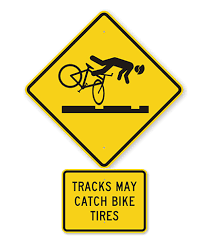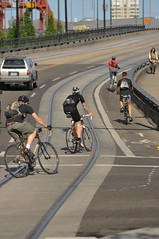Safety: Crossing Tracks
 Peter Sagan may fool around on tracks – you should not. Late this past May one of our PBC members was seriously injured in an unfortunate accident when his bike tire got hung up in train tracks. Negotiating track crossings seems fairly straightforward; Proceed straight across at a right angle to the direction of the tracks, and that’s all you need to know. Well, it’s not that simple.
Peter Sagan may fool around on tracks – you should not. Late this past May one of our PBC members was seriously injured in an unfortunate accident when his bike tire got hung up in train tracks. Negotiating track crossings seems fairly straightforward; Proceed straight across at a right angle to the direction of the tracks, and that’s all you need to know. Well, it’s not that simple.
Here’s a refresher course with the things to do and not to do. It may appear that the “do” items and the “don’t” items are redundant. Well, they are. Some absorb ideas better when affirmatively stated; others are more amenable to the negatively stated. It may have something to do with parental technique. Whether one is better than the other is debatable. Please don’t accuse me of favoring one over the other, and make no assumption based on the order of presentation. ✎
DO:
- Cross tracks perfectly upright (perpendicular to the road surface) without leaning. This is especially important when tracks are wet.
- Slow down before arriving at the track crossing.
- Cross tracks in the direction that is perpendicular (90º) to the direction of the tracks. Often, because the tracks cross your path at an angle less than 90º, you must change the direction of approach to ensure crossing at 90º. First, slow down to give yourself time and room to adjust the approach, and assess whether and to what extent the traffic nearby, or other limitations, might prevent an adjusted approach. Sometimes it’s not possible to adjust to 90º. If so, either cross the tracks on foot or proceed carefully at a smaller angle that would ensure your wheels don’t fall into the gap next to the rail.
- You can cross at 45º if you must, but doing so entails greatly increased risk.
- If you must cross at a less desirable angle, ensure that you keep your front wheel perfectly straight and hold the handlebars securely.
- Always keep your front wheel perfectly straight when crossing.
- Always hold the handlebars securely when crossing.
- If tracks are in the area, ride only where tracks cross the road as opposed to where they are the road. Unfortunately, there are places in Portland where bike lanes have been installed right next to, and parallel to, the rails.
- Coast over the tracks with pedals level at three and nine o’clock.
- Strictly obey traffic control signs and signals at crossings.
- When riding in a group, cross tracks single file.
- Stay within the boundaries of a bike lane guiding you across tracks.
- Keep your tires in full contact with the road surface. Hopping across is only for professionals.
- Crossing tracks with low air pressure in your tires is asking for trouble.
DON’T:
- When crossing tracks, don’t lean the bike to one side or the other, such as to turn, even just a bit. This will increase the odds that the bike will slide out sideways from under you.
- If you enjoy leaning to the left or right as you cross tracks, don’t do it on wet tracks. You just might find that you begin to enjoy it less.
- Don’t apply brakes if you are already crossing on the tracks.
 Don’t ride parallel to tracks. Avoid any street with tracks where you are forced to ride in the same direction as the tracks. There’s a significant risk that something unforeseen may force you left or right and your bike’s wheels into the gap. It’s also probable that at some point you may have to cross the tracks to turn off from the street. Can you really get to a 90º angle to do so? Most likely, there won’t be enough distance or opportunity to get to a 90º position. The Portland Bureau of Transportation should not install bike lanes that run next to and parallel to tracks. Unfortunately, PBOT does do it. Usually, they have provided for turning across the tracks safely by directing bikes to position on a crossing street at 90º. However, this doesn’t make it any safer to ride right next to the tracks.
Don’t ride parallel to tracks. Avoid any street with tracks where you are forced to ride in the same direction as the tracks. There’s a significant risk that something unforeseen may force you left or right and your bike’s wheels into the gap. It’s also probable that at some point you may have to cross the tracks to turn off from the street. Can you really get to a 90º angle to do so? Most likely, there won’t be enough distance or opportunity to get to a 90º position. The Portland Bureau of Transportation should not install bike lanes that run next to and parallel to tracks. Unfortunately, PBOT does do it. Usually, they have provided for turning across the tracks safely by directing bikes to position on a crossing street at 90º. However, this doesn’t make it any safer to ride right next to the tracks.- Don’t cross at less than 45º; it is extremely unsafe. Less than 30º is absolutely dangerous.
- Don’t steer as you cross the tracks. The risk is that your wheel might just get close enough to the direction of the tracks and be forced into the gap. Down you go.
- Don’t grip the handlebars loosely as you cross tracks.
- Don’t be pedaling/spinning, and don’t apply the brakes as you cross.
- Don’t even think about crossing or try to make it across when any signs or signals indicate that it is unsafe.
- Don’t ride side by side with others when crossing tracks.
- Don’t ride outside the boundaries of a bike lane that guides you across tracks.
- Don’t ride across tracks if there is low air pressure in your tires.
- Don’t try to employ any of the various hopping methods for crossing tracks that you may read about. You’re not Peter Sagan.
Alan Mevis, Member at Large/Safety Committee Chair
